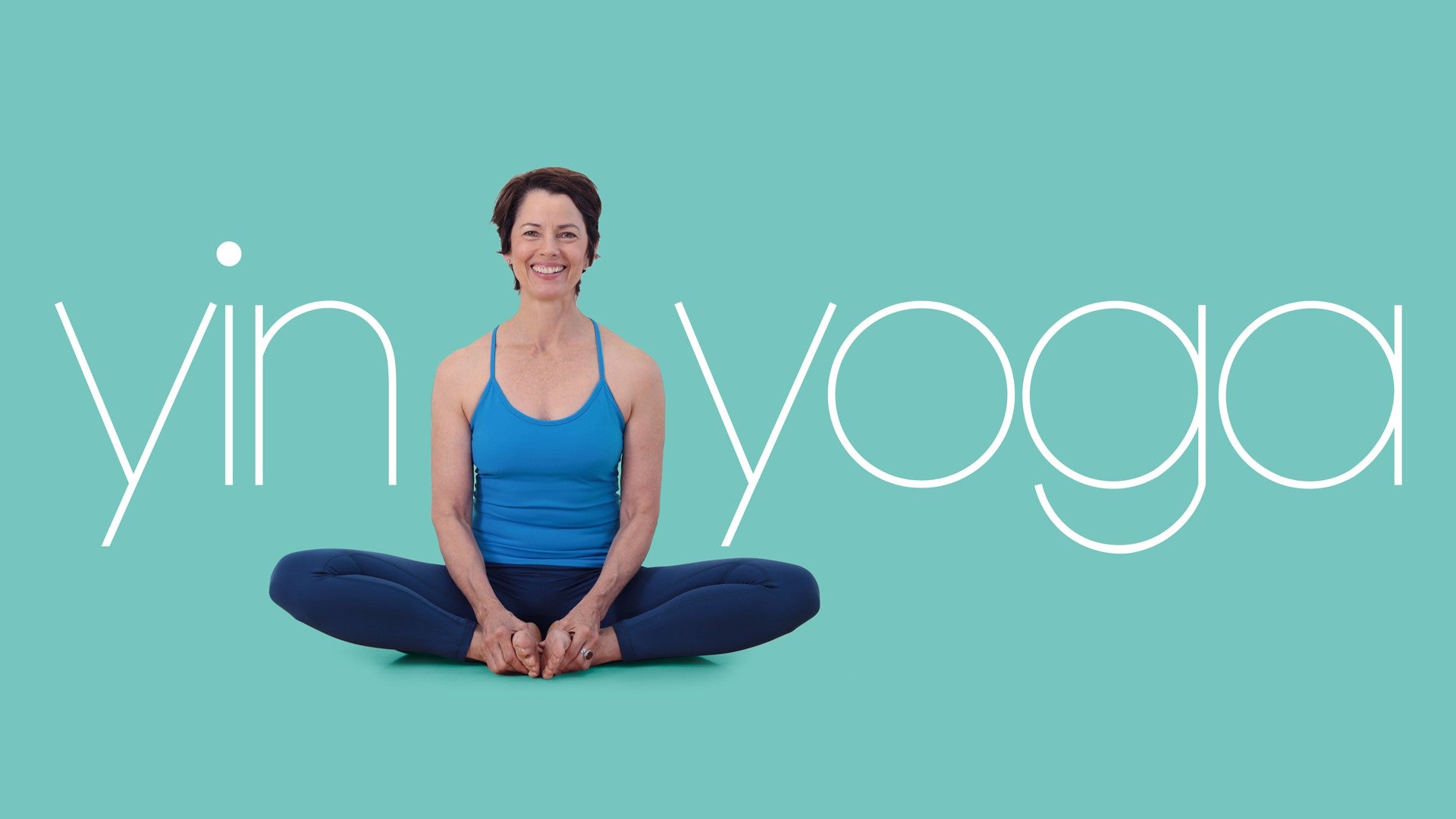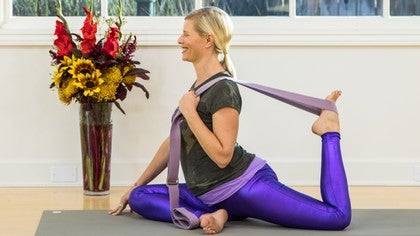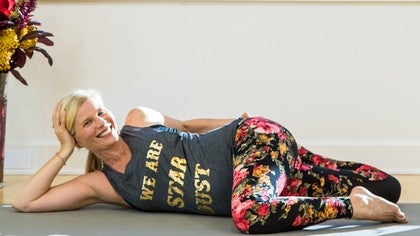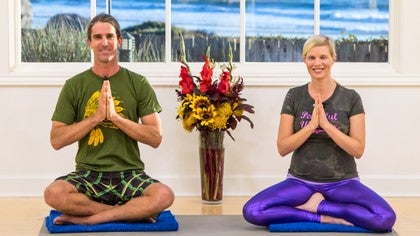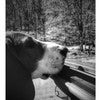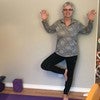Description
Transcript
Read Full Transcript
Hi, y'all. We're going to begin today in meditation. So come to a comfortable seated position. I'm choosing to sit cross-legged and I have a block underneath my hips to prop up my pelvis a little bit. So just bring yourself into a comfortable position. You could even lie on your back if that feels more comfortable. And when you're ready, just start to close the eyes and let's start to draw our attention inward. So this series today is going to be in honor of the spine. So let's just spend a little, a minute or so, not long, but just bringing our awareness to the spine. I'm one of those yogis that always likes to know why I'm doing something. So I want you to draw your awareness to your spine so that you start to feel physically the center of you, that central column that is holding you up in this moment. Sometimes if the mind is a little agitated, it's nice to tune in on a physical level. So feel the weight of your bones. Think of yourself on a skeletal level. In particular, feel the weight of the pelvis. And sometimes when I do this, I slump a little bit in my posture. I almost press the pelvis down into the mat or the block and allow my posture to slump. And then in this position, your sitz bones at the base of your pelvis are like your feet. So stand through the sitz bones at the base of the pelvis and start to slowly grow tall through the spine. So this shouldn't be militant. It shouldn't be a jerking movement. You're like a little sprout growing up towards the sun. And once you do start to feel your spine as tall as feels appropriate today, again, check in with the pelvis. See if you can relax again, heavy down into the anchor of your pelvis. Feel the height of the spine and then totally relax the eyes, the jaw, the forehead. And then a few more breaths here. See if as you inhale, you can feel yourself expand in all directions, the back ribs, the side ribs. So a 360 degree breath with the lungs. And as you exhale at your own pace, feel everything hug back into the center. So to me, the exhale then becomes like an embrace of the spine, a hugging of the spine. You can feel the musculature deep to the spine holding you up. And in your final breaths here, can you feel that you're almost squeezing yourself gently on your exhales like a tube of toothpaste and growing a little taller through the crown of the head. Really nice yogis. So when you're ready, you can start to open your eyes and we're going to come right onto the back. So take your time coming onto the back. So we'll come onto our backs into a twist to begin. So just lie down, ease yourself down onto your back. And if you want to keep your knees bent to begin with with the feet on the floor, you can. That's the way I'm going to come into it. But you also could do this with your legs extended. So I'm going to start with the right leg. I'm going to hug my right leg into my body and then I'm actually going to cross the right leg over the left. I like it. I like it this way. I like to have my legs like in a cross legged position. You could do it with your legs uncrossed if this is uncomfortable. And then I'm going to shift my hips over to the right a little bit. So I pushed into my left foot, shift my pelvis over to the right. And now I'm dropping my thighs over to the left. I know that I need a block. So I'm going to grab a block and put a block underneath my knee to support my twist. We're going to be here about two minutes. So the reason I'm using the block is to take some of the pressure or the stimulation out of my right hip. It's not that that's a bad thing. It's just that I really want to feel this twist more in my spine. And a lot of times if you're really feeling an intense stretch in the outer hip or in the IT band, which is the side of the thigh, it's distracting.
It's like those muscles are yelling at you and you can't hear the spine. So let's listen and see if we can feel or hear the spine. Basically just become as still as you can without feeling that you're holding yourself still. So it's more like you relax into stillness and a lot of times as you relax into stillness and draw your awareness to the spine, the spine starts to do like this little dance for you. It's very subtle, but the spine comes alive and to me it feels like it's spiraling or spinning unraveling, unwinding like a barbershop pole. And we're going to ease ourselves back through center and we're going to come pretty much right onto the other side. So let's just take a little pause in the center just to get ourselves back to neutral. You might take a breath or two here. I might encourage you to minimalize your movements. So try not to pull your knees into your chest or windshield wiper your knees too much. Just settle in and then we'll take it onto the other side. So I'm going to bring my left leg up and over my right like I'm sitting cross legged. You could also just have the thighs together. I like to boost my hips up and shift my pelvis to the left. And then I'm going to drop my knees over to the right. I'm putting the block underneath my knees. You also could put the block or a bolster under your thighs or even sometimes people like a blanket or a block between the thighs. So about two minutes here. What I'm doing when I boost my hips up in the beginning and shifting, when I'm shifting my pelvis over a little bit, when I shift my pelvis over and then I, so say in the beginning I dropped, I shifted my pelvis to the left. I dropped my knees to the right. Now my spine is straight down the center of the mat. It doesn't matter if your spine's not like this, but this just gives me a sense of where I am. Just pay attention to the little micro movements the body is making on its own as you drop into deeper layers of tissue. You can feel these subtle movements all the time. It's just, we're being still enough, quiet enough in our lives right now to feel them, to pay attention to them. Remember this poses homage to the spine. So we're really thinking about the spine. If anything is distracting your attention from the spine, maybe you should see if you can shift the bones until you really feel more awareness to the center of your body. Also, I don't turn my head in one specific direction. Just be comfortable. I'm gonna start to ease myself out, unravel the pose. I'm shifting my pelvis back to the center of the mat and this time I'm going to extend my legs out and I'm gonna rest with my legs extended out. So just a couple of breaths here. You might have your hands on your belly or your ribs or even one hand on the heart, one hand on the belly. I'm choosing to put mine out by my sides with my palms up. So from here, we're gonna come into pontoon pose. So I like a bolster. I've also used a block before. You really can use either, but I'm gonna choose to use a bolster. So I'm gonna bend my knees, soles of the feet to the mat, push into my feet, lift my hips up and slide the bolster underneath my hips perpendicular to the mat. And then you could keep your knees bent if you'd like. I'm gonna choose to extend my legs out. I like that feeling. And then I'm also gonna bring my arms overhead. We'll be here about two minutes. And I even just got into the pose and I'm gonna bend my knees again and readjust. I'm realizing I want the bolster a little bit further down. You really want the bolster or block, whatever's propping up the pelvis, you want it to be under the pelvis. So we have this beautiful lumbar curve. We have this natural curve of the low back and we like to put things in that curve. So a lot of people want to put the bolster or the block in the curve of the low back, but you want the support to be under the pelvis. Sometimes when I first come into this pose, this is pontoon. When I first come into it, I feel a little fidgety, a little restless. I hope you're not feeling that, but if you are, just stay the course. Stay with the pose. It tends to have a very relaxing feeling overall.
Your head's below your heart, so this pose is bathing the brain in fresh blood. I'm already starting to feel my breath change a little bit. You might feel yours as well. So it's helping to stretch the diaphragm a bit at the base of the ribs and also opening up the front of the hip, which is a spot of major blood supply in the body. So we're opening up the front of the hip, the front of the torso, the diaphragm. And then just start to ease yourself out. You can come out fast. I always come out of this pose slowly and that's just my own preference. So don't feel like you have to follow me, but I bend my knees and I come out of this pose in stages. It feels best for me to do it that way. So I've bent my knees. I'm just bringing my arms back down by my sides. And now I'm going to slowly press into the feet and I'm really going to try to use the feet and the legs and the glutes, the buttocks to pick my hips up and slide the bolster out. So I'm using a little bit of the musculature to get me up out of the pose. And the reason I do that is because sometimes you've been so relaxed in pontoon that you can almost get the sensitivity in the low back as you come out. Don't be afraid of that. I'm going to go ahead and extend my legs out on the mat and just rest. So I almost take it as an honor. I'm almost excited when I have a little bit of soreness or ache in the back as I come out of a pose. Not pain, but I want to feel the sensation and feel that I really got into the musculature and to get into the tissue that I'm trying to get into. So I think one of the main parts of yin is don't be afraid of the sensations. Just try to be calm. That is the most helpful to the body when we aren't afraid, we stay calm. So we're going to start to ease our way up and come into a forward fold. So the pose we just did was a back bend. We're now going to come into a forward fold. So I'm going to bend my knees and I'm going to roll over onto my right side and just take my time and ease my way up. All right. So we're going to come into a butterfly, so easing ourselves into a forward fold now. And this is going to be a nice long forward fold. Not too, too long because I'm taking shorter holds in this class. But what I like when I do this pose is I am going to get a block and I'm actually also going to get a blanket. So I'm going to bring the blanket underneath my pelvis. This is kind of a treat. I don't always, for me at least, I don't always do this, but it gives me a little bit of a lift. And now as I roll down off of the blanket a bit, it's going to go ahead and help my pelvis tilt forward a little bit. So you might like to sit on a blanket or a block or a bolster if you want more height. And then some of us who are used to Baddha Konasana, we're really used to pulling the heels all the way in tight. Just let your feet come together and this nice diamond shape of the legs is totally fine. So we're going to come into two forward folds back to back. So we're starting with butterfly which is a two minute pose and then into our next two minute pose. So you can just bring your head forward. I'm using a block under my head. And the reason I'm using it is because when I don't, there's days when I don't, this is going to sound kind of crazy, but I cross train within my yen. So I don't want to do my yen poses the same every time. We get into a habit of poses that we like. But the reason I'm propping my head up today is that I can get into a different part of the spine. I find if my head is propped up, I'm not pulling so much on my neck. So now I'm feeling this pose deeper down in the lower spine. I'm going to lower the block a level. I'm feeling like I can. You might take it away or change the orientation of your block if you're using one. And this pose has a lot of target areas, butterfly, where some of you might be feeling the inner thighs and the groins. I'm feeling that. Some of you also might feel outer hip. I'm feeling that as well. And then you also might feel the spine. So it's okay if you feel one or all of those places. Just check in with the tension in the body. Notice if you're holding on.
I noticed I was. And so we're going to kind of stay low for this next one and just ease up out of butterfly. I'm just moving the block out of my way and I'm going to extend the legs forward. So I'm keeping my head low. You, of course, can sit up if you want, but I'm just going to extend my legs out into caterpillar. My legs are a little wider because I'm pregnant, so I'm making space for the belly, for the baby. And I'm going to come forward and use my arms on the block. So I can't go as low in this pose because of my belly, but you might be able to go lower or you might be propped up a little higher. It's fine either way. So two minutes here. I personally really like this transition from butterfly into caterpillar because we get a nice stretch, warm up in butterfly and then extending the legs out feels good. It's almost like we crimped the hose by having the knees bent in butterfly. And now as we extend the legs out, it's like you can feel the flush of the legs. I'm getting the AOK that my body's letting me drop in a little deeper, so I'm moving my arms and now I can rest my head on the block. And remember, nothing about this pose needs to look pretty. You really just feel the pose. I frankly think that's why yin is not photographed a lot because it's a really deep, intimate practice and it's not aesthetically important. The aesthetics are not important. It's the feeling tone of the pose. And if you think about it, we live in a world where a lot of the aesthetics of yoga is important. So this is our opportunity to not worry about what the pose looks like and just start to really feel what's going on. So my final breaths here, I moved the block so that my head isn't touching. I'm pretty much as deep as I'm going to go in today. And then I'm just going to start to ease out. Take your time. So coming out of these poses can often be, especially forward folds that long. It can be a little dizzying. I kind of like the dizziness. It feels like the pose worked and I'm just going to come down onto my back. If it feels better to sit up for a while, then do that. But if you can, eventually just lay the spine down and really give the spine permission to release. Think about it all day long. We asked the spine to hold us upright. And for a lot of us, we're really depending on the spine. So giving it permission to release is huge. So maybe one more deep breath. Actually, I'm going to say, no, let's stay here a few more breaths if you don't mind. Because I'm just starting to feel a little bit of that swell of spasming in my low back. Remember, it's like a wave. You feel it coming on and we can get a little afraid of the crescendo. But just trust. Be brave and relax, as the great Eric Shiffman says. And now I can feel the spasming just washing out. So now let's come onto the belly and we're going to come into a sphinx. So you can just roll right over onto your belly. I'm going to roll to my left and grab some props. So I'm doing sphinx or seal. I use a bolster and a block and two blocks since I'm pregnant. So you don't have to use both of them. And we'll be here about three minutes. So I'm holding this one a little longer than some of the others. And so you can do it the way I'm doing it with a bolster, but you also could just be on your belly. Imagine I don't have the props at all. The only reason why I'm using the props is to accommodate for the pregnant belly for the little baby. But I'm going to come down onto my forearms for a bit and then you can do whatever you want with your head. And so I really encourage you to explore like dropping the head forward, even tilting the head to the side. Neck movements are really nice here. And if this class is dedicated to the spine, the neck is part of it. So you might even lift your chin. And sometimes I even open my mouth. I don't think anybody's looking at you. I'm not looking at you. You're looking at me making me make I'm making faces so you can even like stick your tongue out. And then I might take it up a notch. So I'm going to start to straighten my arms. I'm keeping my elbows slightly bent.
You can certainly lock your elbows out and that can sometimes be helpful. But I feel like today if I locked my elbows out, it's just a tad bit too much. And that is I think one of the gifts of yin is that it teaches us our thresholds. So I'm relaxing even my kneecaps right now. I can feel that there's somehow tension in my kneecaps. So I'm relaxing that tension. I'm also relaxing the tension in my buttocks. It's fine to use a little bit of muscle, like muscle engagement of the buttocks, but make sure you're doing it intentionally. So sometimes people just come into sphinx and they just really grip in the butt. So maybe feeling in whatever position you're in, feeling that nice opening in the front of the spine, gentle compression in the back of the spine. And my yogi friend, please do not feel like you need to look like me in this pose. The most advanced thing you can do here is listen to your own body. We're all so unique. And that's another beautiful aspect of yin is it's teaching us to be intimate with our own body, and to work within our own parameters. So I'm going to come back down. I'm going to spend the last bit on my elbows again, my forearms. And then you could just either bring your elbows wide and rest your head down. That's a beautiful way to come out of this pose. I can't do that because I've got all these props and I can't rest my belly on the floor. So I'm going to push back to child's pose. So whichever feels most comfortable, we're just going to take a little rebound in whatever position you landed in. And I think it's nice as we rebound for a few breaths. If you love being on the belly, stay there. But at any point, if you want to push back into child's pose, do that. But listen to the body. Try not to let the mind dictate what the body wants. This is really advanced. You're putting the body in first place, which is pretty rare in our lives. The mind usually has center stage. So we're going to come into a forward fold next. I'm giving my spine a little wobble in my child's pose. If you're not already in that child's pose, if you're still in your belly, you might just push back to child's pose just to give yourself that stretch of the low back. So this class is really alternating between forward bends and back bends, which is nice. We're giving some really nice stimulation to the spine. So I'm rolling myself up. I'm going to get the bolster and my blocks out of my way. We're coming into snail pose. And I'm going to use a blanket for this pose, just for a little extra padding on my back. I'm going to come down onto the back. I showed this in another series with a block. I'm not using a block in this series. I'm also liking that this blanket is giving me just a little lift of my shoulders. All right. So we're going to come into snail. So we're going to bring the legs in. If you have any neck issues, you might not want to do this pose, but I will say I have scoliosis of my neck and I do this pose and I'm pregnant and I'm doing this pose. So just be cautious and do what feels right. Trust yourself. So I'm pulling my knees into my chest and then I'm going to start to boost my legs up and over my hips. So my, we're going to be here about two minutes. Yogi's my pre pregnant days. I think I had a pretty nice Halasana or snail, but my knees have to be bent. They have to accommodate for the belly. So again, don't let yourself get wrapped up into what it looks like. That's what's been so interesting about doing yin in this new body of pregnancy. It's all new to me and really we need to be like that all the time as Yogi's maintain our curiosity. So never going into these poses with an agenda, if that makes sense. I'm letting myself shift a little bit because I'm getting different aspects of my spine. As I roll a little bit more and bring my legs towards the floor, my feet down, I can feel myself getting into different parts of the spine. This is, you can hear it's kind of changed my voice maybe, but it's harder to breathe here. This is not just a pregnancy thing. This post has always been hard for me to breathe. So you might be finding that as well. I think this is helpful. There are going to be moments in your life when it's hard to breathe. Practice breathing here. Breathe into new aspects of your lungs, the backs of your lungs. The lungs go all the way up to the neck. Breathe into the tops of the lungs, the sides of the lungs. I'm going to straighten my legs a little bit. It means that I will lose a little bit of the bend in my spine, but I'm feeling a different stretch. You certainly could take this up towards the shoulder stand too. I'm not going to. Then I'm just going to start to ease my spine down. I'm going to come down slowly and I'm actually using my hands to help my legs come down really slow. So now that I've got the bulk of my weight down, my pelvis and my torso, I'm just going to slowly start to bring the rest of the pelvis down. So like my tailbone was lifted. Now I'm starting to slowly bring my tailbone down. I can already feel that deeper breath come back in, which is so nice. I'm starting to feel that wave of a crescendo towards a little spasm, but I'm not afraid. I still have my hands on the backs of my thighs. I'm still kind of holding my legs up and then I lower my legs one at a time. So I'm pulling my left leg into the body. You don't have to do it this way, but I'm pulling my left leg in and so I can just lower my right leg easily to the mat. Like that required no effort beyond a little bit in my upper body. And then I'm going to just lower the left leg down, kind of pushing into the right foot. So I stay balanced. I'm going to shift myself a little bit so that I'm more on the blanket. If you were using a blanket and want to kind of shift and then I'm just going to gently extend my legs out on the mat and just take a little rest. Again, try to keep the movement if you can to a minimum.
Not because we're trying to be militant, but because we're trying to be yogi scientists. We're trying to observe. So you might notice in these final breaths that the spine starts to settle a little bit more. And what I'm feeling is my spine really settle and I'm feeling a lot of movement from the baby. So I think it likes snail. Alright, so we're going to start to ease our way up. So we're going to come into a back bend now. We just did our forward fold. We're going into our back bend. So I'm going to roll over onto my right side and start to make my way up. The spine might be a little sore and I think people are surprised by that. We're used to being sore from more young, more muscular stuff and you might be getting a little sore from non muscular stuff, which is interesting for us. So we're coming into full saddle, but mostly what I should say is don't worry about that. Don't be, don't let yourself be troubled. So full saddle, I'm sitting back in between my heels. My knees are bent and I could bring a block underneath my hips that would underneath my pelvis that might feel good. You would just slide a block underneath your hips like this and sit back and then lean back. If you did that, you might want a second bolster or even a third, but I'm not going to use the block and I'm going to just settle in between my feet and I'm going to start to lean back. I have my blanket nearby because I know I want to use that under my head. So I'm going to come back into my saddle. Full saddle, I'm easing myself down. You don't have to go all the way down and I'm going to bring the blanket underneath my head. I like that. Just gives a little support to the neck. About three minutes here and just feel free to do whatever you want with the hands. So sometimes having the arms out feels good. Sometimes having the hands on the ribs feels good. Having the arms overhead might feel nice. I've seen people who like to give their feet a little massage in this pose. So one of the things I love about saddle as a pose is that what's happening right now in your body is the stretch of the quadriceps. So having the knees bent like this is stretching the front of the thighs. And this stretch on the quadriceps is actually anchoring the pelvis. It's like the pelvis is tethered by the stretch of the quadriceps. So you've tethered the pelvis somewhat and then you start to lean back over the bolster and you get this really nice back bend. So sometimes people can feel the stretch lower or the stimulation lower in the spine, like down near the sacrum or the lower lumbar vertebra. And these lower lumbar vertebra are hard to access. They're bulkier vertebra because they're at the base of the spinal column. So they're carrying really the weight of the spinal column. So they're bulkier, they're sturdier. And they're also kind of nestled in between the pelvis so they don't get as much movement. And this is where most people have low back problems. Down there, L4, L5, S1. So we're hopefully getting into that area. I feel it in my own body. Your feet can be flexed as well and your knees could be wide or narrow. Remember, we're not worried about what the pose looks like. We're really looking for the feeling tone. In your last few breaths here, I hope you can feel that pulsing of the blood through the quads, through the pelvis, even up and through the front of the torso. And then just start to move yourself out. So you could either roll to a side. I'm going to come up through the center. I'm going to use my hands. I'm even using a little bit of a grab onto the edge of the mat. So just get creative. Whatever gets you in and out is the best way to do it. And then I'm just going to gently bring my legs out from under me. And I'm not moving fast. Because the body's a little bit vulnerable right now. And I'm going to keep the bolster the way it is and then just come back. You could move the bolster if you want. I'm going to let my arms come out to the side and just take a little rest here. So I'm feeling the circulation back into the thighs, back into the legs. Feels really nice. So for our final poses, we're going to actually do another back bend. We're ending with a pose called Cat's Tail. So just start to ease yourself up. And you can stay there as long as you like, of course, but I'm going to ease myself up. And I'm going to need my blanket. I like a blanket, a strap, and a block for this one. So this is a beautiful pose because it's an asymmetrical pose, meaning we do one side and then the other. But it's a twisted back bend and rarely is the spine in this orientation.
So I like a strap. You don't have to use a strap. I like a blanket under my hips. It gives me a little bit more padding. And I like the block for my head. So I'm going to come down onto the belly and we're going to, I'm going to, I'm going to kind of come onto my right hip just to avoid my belly. And then I'm going to bend my left leg up. So if you are familiar with lizard pose, I'm, I'm starting in lizard. And if you feel like this is enough, this might be where you stay for two minutes each side. So this is a great alternative is just to stay in lizard. If you want to take it a little bit further into Cat's Tail, what you're going to do is roll away from your left leg. So you're going to roll away from the bent leg onto your right shoulder. And now I'm putting my head onto the block. You could use a blanket or a bolster, or you could even just rest your head on your, on your right forearm. And then I'm going to bend my, so my left leg is already bent. I'm going to bend the leg that isn't bent. I'm going to bend my right leg and reach back and grab one. So I've got the, my foot okay, but I like to use a strap because I found that if I hold the pose for a while, it starts to bother my shoulder. So I bring the strap up and over my shoulder. I've seen people bring it under their armpit. You don't have to use a strap at all. You could just hold on with the hand to the foot. And we'll be here about two minutes. So a twisted back bend. And so the more you open your spine up to the ceiling, meaning like if you look up more, you turn your head maybe and look up towards the ceiling, open the chest towards the ceiling, it usually becomes more of a twist. And if you stay more on your side and bend the right leg in deeper, you usually get more quadricep. So some, some of us use this purely as a quad stretch. You might be using it. I'm using it as a quad stretch. I feel it in my right quad. I even feel a little bit in my left inner thigh and I'm feeling it in the back as I twist. In my last few breaths, I'm actually going to move the block out of the way and just really let myself open up towards the ceiling. We forebend and twist a lot throughout our day. You know, we bend over to pick up keys or pick up the newspaper. That's a forebend and often there's a twist, but we don't back bend very much and twist. So that's what this is. It's taking the spine into a, into an orientation it's not necessarily used to.
And because of this new orientation for the spine coming out of the pose can be really interesting. So I'm going to unleash my right foot and you could rebound on the belly or on the back. I'm going to kind of rebound on the side just to accommodate for my belly. I'm just resting my head on my right arm and taking a few breaths here. I think this pose has one of the nicest rebounds because the spine is not used to this. So it's like this new sensation. So you come out and it's, it's a good one, a good rebound and then we start to make my way onto the other side. So I'm going to bring the left leg back out onto the mat. I'm going to shift over onto my left hip bone. I'm going to bend my right leg. So I'm up into lizard pose with my right leg bent. I'm going to move the block so it's there for my head. And then I'm just shifting onto my left hip. I'm going to put my head down on the block. I'm going to bend my left leg. So my right leg's already bent. I'm bending my left leg and I'm going to reach back and grab one with my right hand. So my right hand is coming to my left foot. I could stay there, but I'm going to use the strap. The strap also allows me, I don't know if you, you might not have seen it, so I'll tell you, but the strap allows me to maneuver my left thigh a bit so that I am, so I get a deeper quad stretch. And I'm even going to, on this side, use my right hand on the mat just to kind of shift myself a little bit and get myself a little deeper. Again, we're here two minutes. We've already had a little time here. So a nice stretch of the lower abdomen. Some of you might feel that, a nice stretch of the belly, the front ribs. And like I did on the other side, I'm just choosing to remove the block for the last bit, let the head drop down and open up more towards the ceiling so it becomes a bit more of a twist. Sometimes when people are in this pose too, they don't feel much, which is crazy because if you're feeling a lot, you're like, how could people not feel anything in this pose? But there are some students that I know of that come into this. They don't feel it a lot. If you're one of those people right now, just stay with it. Try to feel the subtleties of it. There's something there to be felt and trust that when you come out, the sensation of coming out might be very rich despite the fact that the pose itself was a little bland. So we'll try to ease ourselves out. Let's see if we get a nice rebound on this side. So I'm going to just use my left arm as a pillow. I'm resting on my side simply because of my pregnancy. You're welcome to rest on the belly or the back. Your body will just kind of roll into one position. Let it do what it wants to do. Personally, I'm really feeling the body just take these little, well, they're actually bigger shifts. My knee is kind of sliding on the floor. I'm feeling like my body is really letting go after that. I'm just going to start to ease myself up and we're going to finish our practice today back in our meditation position. So I'm going to get my props out of the way. I started off seated on a block, and I'm going to finish seated on a blanket. So my main yin teacher is Paul Grilly and one of my favorite things that he says sometimes at the end of a class is all the world is spinning even the stars only the spine is still. So feeling the spine as your axis Monday, your own personal center. This is so helpful for me in times when there's a storm all around or it feels like that. I'm just withdrawing all your energy, all your awareness into the spine and let your body make little micro movements. You know, I'm lengthening through the back of my neck. I'm kind of growing taller through the crown of my head without getting tense. My body is taking on its own these little micro movements adjusting itself and I'm just the observer. The altar of the Yogi is the spine. So let's just spend our final breaths here. Noticing the spine giving it the attention it deserves and feeling how in return as we give it attention, give our spines the attention they deserve.
The spine seems to just hold us up. If you're not feeling that right now, it's okay. Yogi friend, be looking for it. And just make sure as you finish your final breaths that you're exhaling completely. So exhale to completion. I'm so grateful you were here with me today. I really wouldn't have been the same without you. So thank you so much. Namaste.
Yin Yoga: Kate Smith
Comments
You need to be a subscriber to post a comment.
Please Log In or Create an Account to start your free trial.
